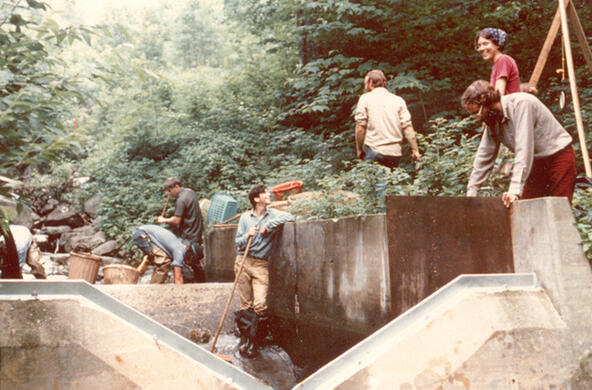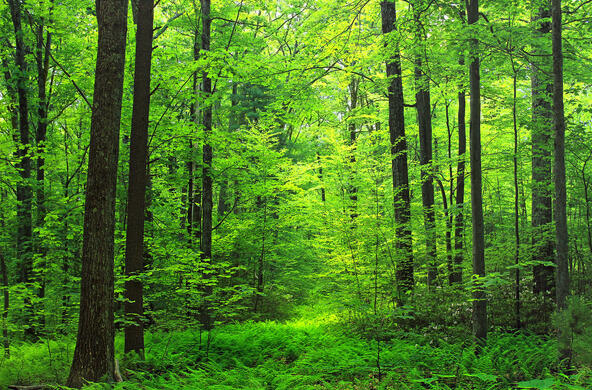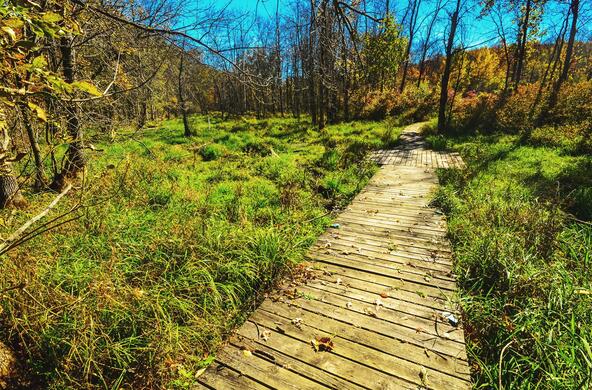The next time you find yourself reaching for your umbrella, take a moment to consider the fate of rainfall after it hits the ground. While some rain is absorbed by natural ground cover, such as fields or forested areas, a high percentage becomes stormwater delivered to our rivers, creeks, ponds and lakes.
Season, environment and development all play a role in how stormwater is formed and transported. During the spring, because soils are often already saturated, the impact of rain is more pronounced. However, stormwater has a major effect on our freshwater resources throughout the year. Managing stormwater is essential to conserving drinking water supplies, protecting wildlife and providing opportunities for recreation.
How stormwater forms
When it rains, hard surfaces such as roads, driveways and roofs prevent water from seeping into the soil. Instead, most of this stormwater is channeled into storm drains that rapidly transport it to the closest body of water. Unfortunately, this can compromise the health of freshwater systems.
As stormwater travels across the ground, it picks up pollutants, including fertilizer, pesticides, road salt, oils, sediment and even trash. Stormwater washes pollutants from the land into our lakes and streams; in fact, polluted runoff is the main cause of water quality problems for tributary streams leading to the Hudson estuary.
Through the storm-drain system, stormwater travels more quickly to streams than it would under natural conditions. This can cause increased flooding and erosion in receiving water bodies, as well as degraded habitat for resident wildlife.
Solutions at home
Individual actions can make a big difference in stormwater management. Rerouting gutters and installing rain gardens are both steps in the right direction.
On many homes, roof gutters drain onto driveways, forcing runoff to travel across paved surfaces before making its way into the storm drain. By rerouting downspouts into vegetated areas, water can infiltrate the soil and be used by plants.
Rain gardens are an attractive option designed for this purpose. These plant-filled depressions collect runoff, trapping pollutants, slowing the flow of the water and helping to recharge groundwater supplies. When planted with native species, rain gardens also provide valuable resources for local wildlife.
Gutter rerouting and rain gardens are both examples of green infrastructure, which is defined as natural areas and engineered systems that manage stormwater by reducing runoff at its source.
Green infrastructure basics
Green infrastructure maintains or restores water's natural flow pattern by allowing it to slowly infiltrate the ground, as opposed to traditional "gray infrastructure" such as catch basins, pipes and culverts that take stormwater away from sites and dump it into streams all at once.
Rain gardens and gutter rerouting are examples of green infrastructure on a small scale. On a larger scale, green infrastructure can include preserving and restoring natural areas, such as forests, floodplains, wetlands and stream buffers, coupled with reducing hard surfaces by paving smaller areas.
Green infrastructure is often less costly than other forms of stormwater management and can increase land values. These practices can improve air quality, have a cooling effect during hot summer months and beautify neighborhoods.
Because stormwater has a large impact on our freshwater resources, green infrastructure is an important step in better managing runoff and improving water quality. At the same time, green infrastructure can have a positive impact on our neighborhoods and communities. Homeowners, businesses, planners, municipalities and many others play important roles in this effort.
Interested in learning more about freshwater conservation? On April 16, the Cary Institute of Ecosystem Studies and Cornell Cooperative Extension Dutchess County will offer a freshwater forum. The event will provide participants with insight into the quantity and quality of regional freshwater resources, pressures they face and management strategies for protecting them, with special attention given to stormwater and green infrastructure.
Emily Vail is the estuary watershed outreach specialist for the Hudson River Estuary Program of the New York State Department of Environmental Conservation. At the April 16 freshwater forum, she will co-present a session on stormwater management and green infrastructure.







